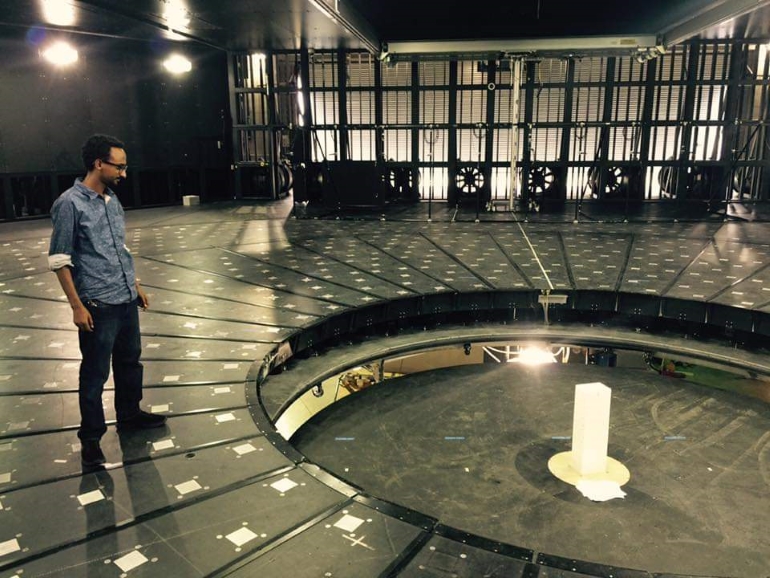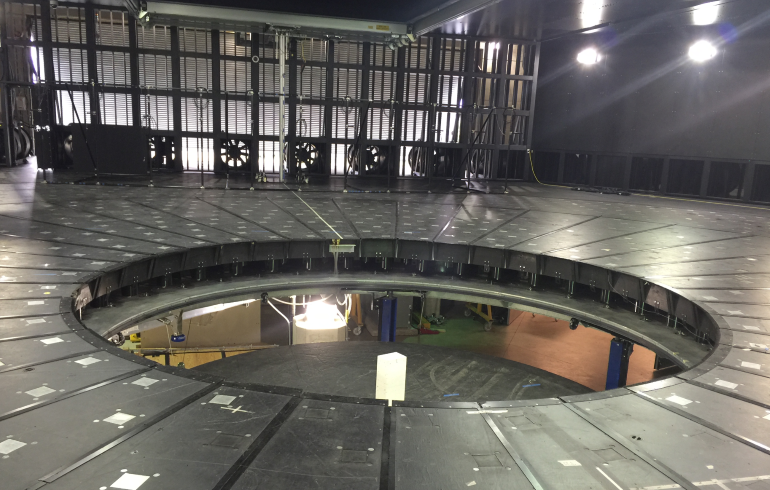
UBC Okanagan researcher Matiyas Bezabeh is studying the effect of extreme wind loads on tall timber building models at the Wind Engineering, Energy and Environment Research Institute
Researchers investigate making buildings stronger to endure devastating winds
New research from UBC Okanagan’s School of Engineering and Western University provides a roadmap to safer building designs in tornado-prone areas.
With the exception of nuclear facilities, current building codes across North America do not specifically address tornado risk. This is due to a variety of factors including the low probability of occurrence and costs, explains Matiyas Bezabeh, a doctoral student at UBC Okanagan.
But tornados do happen—even in Canada. On September 25, six tornados with wind speeds between 135 and 175 kilometres per hour touched down in the Ottawa-Gatineau region, causing $300 million dollars worth of damage. And in 2011, a tornado in Goderich, Ontario caused about $110 million in damages according to insurance estimates.
America’s Wind Hazard Reduction Coalition also states that tornadoes claim nearly 100 lives each year in the United States and account for nearly a billion dollars in property damage.
“The potential damage of tornadoes is extensive, so as structural wind researchers we have been turning our attention towards tornado-structure interactions and tornado-induced wind loads on civil structures in recent years,” explains Bezabeh.
In collaboration with Girma Bitsuamlak, research director at the WindEEE Research Institute at Western University and UBC Okanagan Engineering Professor Solomon Tesfamariam, Bezabeh investigated the impact of tornado-like winds on structures. His research focuses on mass-timber buildings—those built with cross-laminated timber for walls and floors and glued-laminated products for beams and columns.
In Canada and the United States, the intensity of tornadoes is measured using an Enhanced Fujita scale (EF-Scale) based on the damage caused. According to research, buildings designed to a 1-in-50-year wind load can withstand weaker tornadoes with a low EF-Scale—wind speeds less than 175 kilometres per hour—but do not fare as well against tornadoes with higher intensities.
“Increasing the lateral stiffness by adding core walls and bracings could make mass-timber buildings able to withstand higher intensity wind loads,” says Bezabeh. “Furthermore, increasing the dead weight of buildings and incorporating tension piles (rock anchors) as part of the foundation system can also lower the risk of collapse.”
While his research was specific to mass-timber frames, Bezebeh points out his results address potential mitigating factors for all types of buildings.
Bezabeh's research was recently published in the Journal of Wind Engineering and Industrial Aerodynamics and Engineering Structures. He is already looking ahead to the next stage of his research where additional experimental tornado tests will be conducted on an assortment of low-, mid- and high-rise mass-timber building models to develop a performance-based tornadic design framework.

The Wind Engineering, Energy and Environment Research Institute is a hexagonal wind chamber that can stimulate wind patterns and create hyper-realistic tornadoes.
About UBC's Okanagan campus
UBC’s Okanagan campus is an innovative hub for research and learning in the heart of British Columbia’s stunning Okanagan Valley. Ranked among the top 20 public universities in the world, UBC is home to bold thinking and discoveries that make a difference. Established in 2005, the Okanagan campus combines a globally recognized UBC education with a tight-knit and entrepreneurial community that welcomes students and faculty from around the world. For more visit ok.ubc.ca.
 Feds halt activist deportation
Feds halt activist deportation 'Smart' lawyer suspended
'Smart' lawyer suspended First Nation solar farm plans
First Nation solar farm plans Searching landfill for woman
Searching landfill for woman Poland urges more spending
Poland urges more spending Cutting rates at own pace
Cutting rates at own pace Israeli strike played down
Israeli strike played down Full Trump jury seated
Full Trump jury seated World's largest election
World's largest election  Lawsuit over missing nuts
Lawsuit over missing nuts Investigating pipeline blast
Investigating pipeline blast TikTok testing new app
TikTok testing new app Warriors ready for Round 2
Warriors ready for Round 2 Kalamalka Bowl cancelled
Kalamalka Bowl cancelled Rockets live to fight on
Rockets live to fight on Hilton teams up with Sia
Hilton teams up with Sia Swift still 'can't forgive' Kim
Swift still 'can't forgive' Kim Grimes to ‘cap the disarray’
Grimes to ‘cap the disarray’


